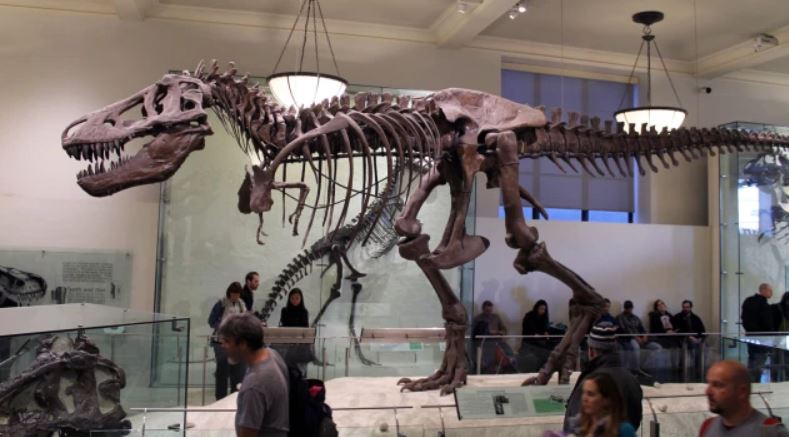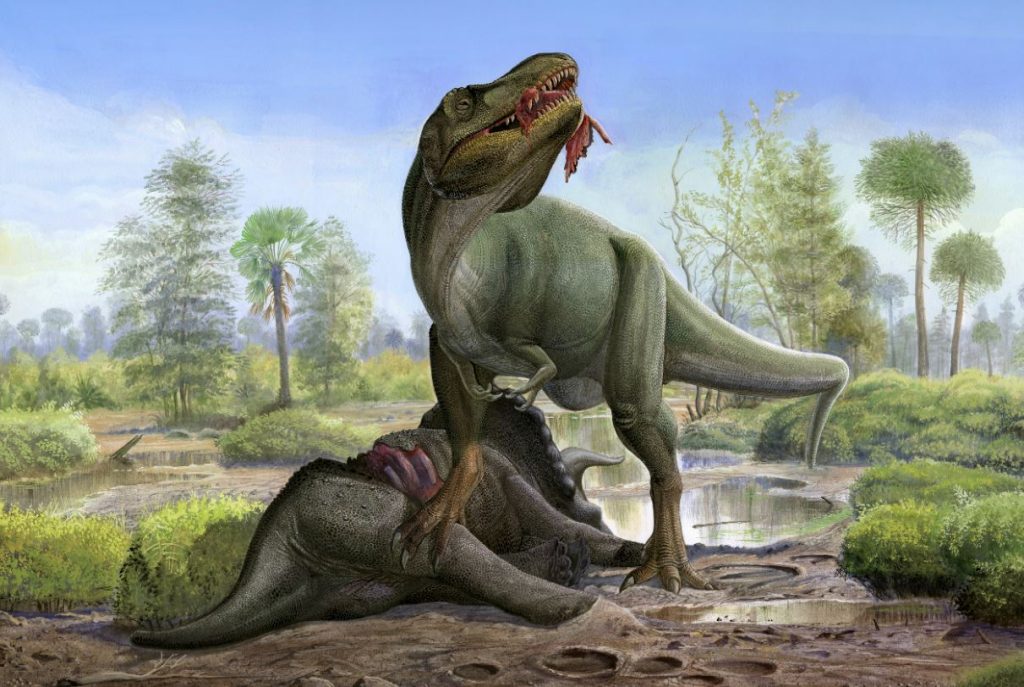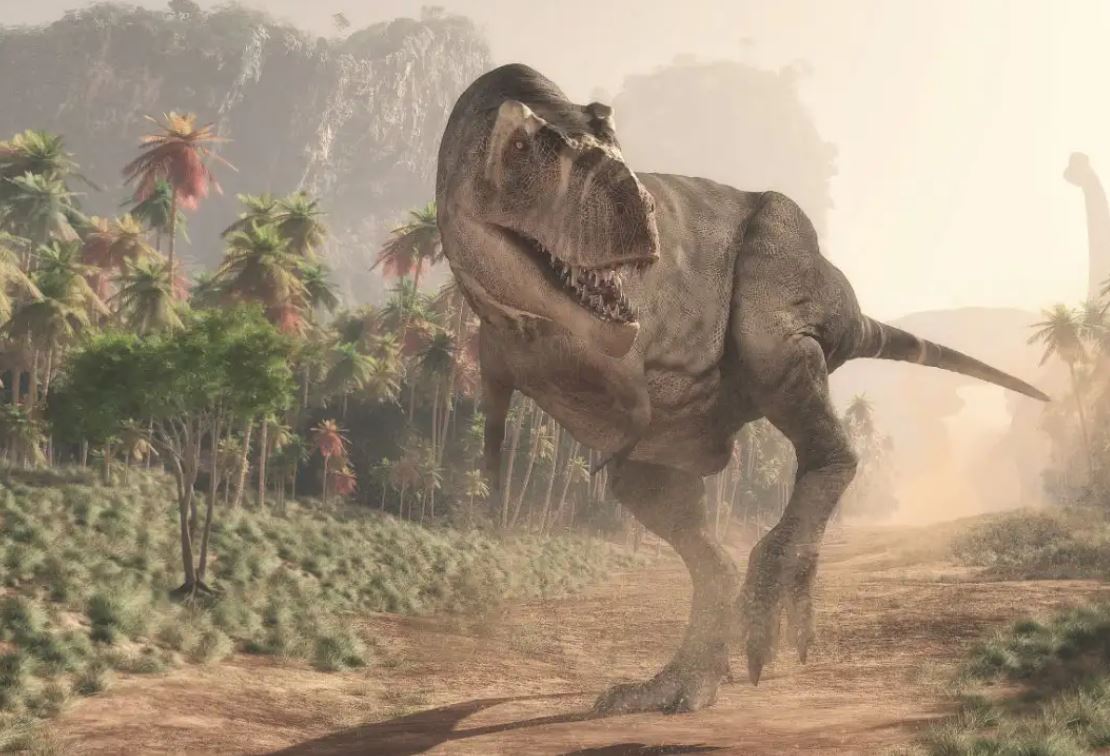Tyrannosaurus rex, also known as T. rex, was a carnivorous dinosaur that roamed the western United States during the Late Cretaceous period. This massive predator, reaching lengths of up to 13 meters (43 feet), holds the title for one of the largest land predators in history. It coexisted with other famous dinosaurs such as Triceratops and Ankylosaurus.
The Ultimate Guide to T. Rex
Explore the ultimate guide to T. rex, where you’ll discover intriguing details about this renowned dinosaur. Uncover fascinating facts about its habitat, diet, possible presence of feathers, and the mystery surrounding its diminutive arms.
T. Rex’s Characteristics

T. rex was an imposing dinosaur with a sturdy body, powerful hind legs, and a long tail. Despite its massive size, its arms were relatively small in proportion to its body.
The T. rex had an exceptionally large and robust skull, with the largest specimen measuring 5 feet (1.52 meters) in length. Previous depictions often showed T. rex standing upright with its tail supporting its body. However, recent studies of its skeleton suggest that it likely maintained a horizontal posture, balancing its considerable weight over its hips.
The dinosaur possessed two clawed fingers and a vestigial third finger without a claw on each hand. Its feet featured three primary claws, along with a smaller fourth claw positioned higher up, resembling a dewclaw found in dogs.
With 54 to 60 long and sharp teeth, T. rex possessed an incredibly powerful bite force. The teeth varied in shape, with front teeth designed for cutting and rear teeth built for strength.
T. Rex’s Remarkable Bite Force
Scientists estimate that T. rex had the strongest bite force among all land animals, past or present. According to a study, a single tooth positioned at the back of its jaw could exert a bite force ranging from 35,000 to 57,000 Newtons, which surpasses even the bite force of a saltwater crocodile, the strongest among living species.
Paleontologists infer the dinosaur’s powerful bite from the robust structure of its jaw muscles, which were firmly attached to its skull. Fossilized remains of T. rex dung, known as coprolites, contain bone fragments, indicating that the dinosaur swallowed bones along with its prey. Additionally, fossilized skeletons of other dinosaur species, like Triceratops, exhibit broken bones that could be attributed to T. rex bites.

T. Rex’s Senses and Hunting Adaptations
Beyond its formidable teeth and bite force, T. rex displayed characteristics suggesting it was a skilled predator. Its forward-facing eyes, more pronounced than those of other tyrannosaurids, and its broad head shape, wider at the back than the front, likely enhanced its binocular vision, aiding in judging distances—a crucial skill for a hunter.
T. rex is believed to have possessed excellent eyesight, complemented by a well-developed sense of smell, evident from the size of its olfactory bulbs, responsible for detecting odors. These acute senses would have facilitated the dinosaur in locating and stalking its prey.
With a relatively short yet flexible neck, T. rex could swiftly change direction to capture fleeing animals.

T. Rex’s Size and Speed
T. rex measured between 11.4 to 13 meters (37 to 43 feet) in length, standing around 3.96 meters (13 feet) tall at the hips. Its weight ranged from 5.4 to 8.87 metric tons (5.95 to 9.77 short tons). The dinosaur’s bones were hollow, reducing its overall weight.
Comparisons have been made to convey the scale of T. rex’s size. It outweighed five Toyota Corollas combined, and if it existed today, it would effortlessly peer into upstairs windows.
The largest T. rex specimen ever discovered, named “Scotty,” measured approximately 13 meters (43 feet) in length and weighed an estimated 8.87 metric tons (9.77 short tons). Another notable specimen, “Sue,” had a maximum length of 12.8 meters (42 feet) and weighed around 8.462 metric tons (9.33 short tons).
While T. rex was undeniably one of the largest land predators in history, it was still smaller in comparison to colossal sauropod dinosaurs like Brontosaurus and Argentinosaurus.
In terms of speed, T. rex is believed to have had a maximum running speed of about 25 mph (40.23 km/h). However, estimates vary among paleontologists, with some suggesting speeds as high as 45 mph (72.42 km/h) and others proposing lower speeds of 11 mph (17.7 km/h).
To put this into perspective, even the world’s fastest-recorded human, Usain Bolt, with a top speed of 27.79 mph (44.72 km/h), would struggle to outrun Tyrannosaurus rex.
Studies based on fossilized trackways indicate that T. rex’s walking speed was likely around 3 to 5 miles per hour (4.83 to 8.05 km/h). A recent comprehensive study taking into account the dinosaur’s anatomy, including its long tail, suggests a walking speed just under 3 mph (4.83 km/h), comparable to that of a human.
Did T. Rex Have Feathers?
While no T. rex fossils with feathers have been found to date, some paleontologists speculate that T. rex may have had at least partial feathering, particularly during its early stages of life. The existence of feathered tyrannosauroids like Yutyrannus from the early Cretaceous provides evidence supporting this idea.
Additionally, the presence of primitive feathers in theropods like Sinosauropteryx suggests that later theropods, including T. rex, could have also possessed feathers.
What Does Tyrannosaurus Rex Mean?
The name “Tyrannosaurus” derives from the Greek words “tyrannos” meaning “tyrant” and “sauros” meaning “lizard.” The term “rex” originates from Latin, translating to “king.” Therefore, Tyrannosaurus rex can be interpreted as “tyrant lizard king” or “king tyrant lizard.”
T. Rex Vs Tyrannosaurus Rex
Both “T. rex” and “Tyrannosaurus rex” refer to the same dinosaur. In scientific literature, the initial part of a species’ name can be shortened to an initial (such as “T.”) to avoid repetition. Hence, Tyrannosaurus rex is commonly abbreviated as T. Rex. Variations like T rex and T-rex also denote the same species.
T. Rex Is A Species
Unlike many dinosaurs identified by their generic names (such as Spinosaurus and Triceratops), Tyrannosaurus rex is one of the few known by its full two-word species name. T. rex represents an individual species rather than a grouping that could encompass multiple species.
It is important to note that although several other species within the genus Tyrannosaurus have been proposed, T. rex remains the widely accepted species.

T. Rex’s Family and Classification
T. rex belongs to the family Tyrannosauridae, a group of theropod dinosaurs that lived during the Late Cretaceous period. The family includes various genera, with the exact number subject to change as new research emerges.
Other members of the Tyrannosauridae family include Lythronax, Daspletosaurus, Gorgosaurus, Albertosaurus, and Tarbosaurus. Among these, Tarbosaurus is considered the closest relative to T. rex, with some paleontologists proposing it as a potential ancestor of T. rex.
When Did T. Rex Live?
T. rex inhabited the Earth approximately 68 to 66 million years ago during the Maastrichtian age of the Late Cretaceous epoch. It existed right up until the Cretaceous-Paleogene extinction event, which marked the extinction of all non-avian dinosaurs.

During the Late Cretaceous period, the continents were taking on their modern forms, and North America was divided by the Western Interior Seaway. T. rex resided in an island continent called Laramidia, which corresponded to what is now western North America.
Where Did T. Rex Live?
T. rex’s habitat was mainly concentrated in Laramidia, the western part of North America during the Late Cretaceous. However, due to the presence of the Western Interior Seaway, which divided North America, it lived in a specific region rather than spanning the entire continent. Fossil discoveries indicate that T. rex inhabited areas that currently encompass parts of Montana, North Dakota, South Dakota, Wyoming, and even Canada.
Who Discovered and Named T. Rex?
The first fossils attributed to T. rex were discovered by American paleontologist Barnum Brown. In 1900, Brown unearthed the initial T. rex fossil in Wyoming, followed by another specimen in Montana’s Hell Creek Formation two years later.
The fossils made their way to Henry Fairfield Osborn, an American paleontologist and the president of the American Museum of Natural History at the time. Osborn named the fossils Dynamosaurus imperiosus and Tyrannosaurus rex in 1905. Upon realizing that both fossils belonged to the same species, he ultimately chose Tyrannosaurus rex as the preferred name.
How Many T. Rex Existed?
Estimating the population of T. rex throughout history poses a significant challenge. However, a study led by paleontologist Dr. Charles R. Marshall and his team aimed to answer this question. By applying Damuth’s law, which relates body size to population density in living animals, and considering T. rex’s metabolism and ecological niche, they derived probable population estimates.
The study suggests that approximately 20,000 T. rex individuals may have coexisted at any given time. Furthermore, they estimated that around 2.5 billion T. rex lived throughout the species’ existence. It’s worth noting that only a fraction of T. rex individuals have been preserved as fossils, with one fossilized individual representing approximately 1 in every 80 million individuals.
T. Rex Skeleton Fossils
Since the discovery of the holotype specimen, numerous T. rex fossils, including several nearly complete skeletons, have been found. Notable examples include “Sue,” discovered in South Dakota in 1990, “Scotty,” found in Saskatchewan in 1991, “Thomas,” unearthed in Montana in 2003, and “Trix,” discovered in Montana in 2013.
What Did T. Rex Eat?
T. rex was a formidable predator, preying on a variety of dinosaurs and other animals in the Late Cretaceous ecosystem of western North America. Its potential prey included Edmontosaurus, Triceratops, Leptoceratops, Ankylosaurus, Pachycephalosaurus, as well as smaller theropods like Ornithomimus and Struthiomimus.
While T. rex is known for its predatory nature, there is evidence suggesting that it also scavenged for food. Some T. rex specimens show bite marks that indicate interactions with other T. rex individuals, which could be attributed to fighting, cannibalism, or scavenging.

T. Rex’s Hunting Strategies
Tyrannosaurus rex likely employed short bursts of speed to capture its prey, as its large size made long-distance pursuits impractical. While hunting is believed to have been its primary means of acquiring food, scavenging may have played a significant role as well. T. rex possessed a keen sense of smell, indicating its ability to locate carrion and scavenge for food.
The debate surrounding T. rex’s hunting behavior continues, with some scientists suggesting that its intelligence and large brain size could have enabled it to hunt in packs. Cooperation and teamwork among individuals might have given T. rex an advantage when pursuing larger prey.
The Purpose of T. Rex’s Arms
T. rex’s arms, though relatively short, were not entirely vestigial. While their small size raises questions about their functionality, the presence of robust muscles attached to the arm bones suggests that they served a purpose. Various theories have been proposed, including using the arms to hold prey close to the jaws while feeding or aiding in getting up from the ground. However, the arms were too short to effectively deliver food to the mouth.
T. Rex in Pop Culture: Jurassic Park and Beyond
Tyrannosaurus rex has captivated the popular imagination and has become an iconic dinosaur, frequently depicted in movies, books, and other media. In the Jurassic Park film franchise, T. rex plays a prominent role as both an antagonist and, at times, an antihero. Memorable scenes feature the dinosaur’s roaring presence, such as the climactic encounter during the ill-fated car tour or its dramatic intervention to save human protagonists.
While T. rex met its demise at the jaws of Spinosaurus in Jurassic Park III, it made a triumphant return alongside Velociraptors and a Mosasaurus to save the day in Jurassic World.
Top Ten T. Rex Facts Recap
To summarize the key points about Tyrannosaurus rex:
1. Tyrannosaurus rex means “tyrant lizard king.”
2. T. rex inhabited Laramidia, a western part of North America during the Late Cretaceous.
3. It lived approximately 68 to 66 million years ago.
4. T. rex measured 11.4 to 13 meters (37 to 43 feet) in length and weighed 5.4 to 8.87 metric tons (5.95 to 9.77 short tons).
5. It had 54 to 60 long, sharp teeth, with the largest tooth measuring over 30 cm (12 inches).
6. The existence of feathers in T. rex is still debated among paleontologists.
7. T. rex was likely a hunter, but scavenging might have also been part of its feeding behavior.
8. Its arms, although small, had muscular attachments and had potential functional uses.
9. T. rex played notable roles in the Jurassic Park film franchise.
10. The population estimates suggest that around 20,000 T. rex individuals existed at any given time, with approximately 2.5 billion individuals throughout history.
Tyrannosaurus rex remains a captivating and enigmatic dinosaur, leaving us with an enduring fascination for its incredible size, power, and role as the ultimate predator of its time.
